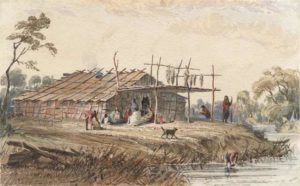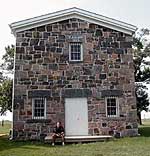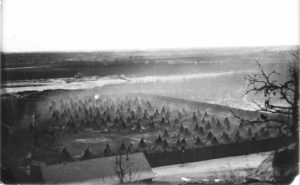Use Cmd/Ctrl+F to search Dakota War (1862)
Working links are Red, other references, use Navigation Panel choices.
Names in bold will be found in Players or Dictionary
Bolded Titles in References – Books (two lists).
Dakota War (1862)
(An Expanded Timeline *)
aka:
Little Crow’s War, the Dakota Conflict
the Dakota Uprising, Sioux Uprising
the U.S.-Dakota War of 1862
* FYI: Since Old West Daily Reader seeks to understand the Old West and its influence on today, this page, about this tribe, these incidents, is presented as a microcosm of the treatment and fate of Native Americans, in general, as the nation (The U.S.) moved west and became what it is in today’s world. True, these were the ways of the times and this is the worst example of the country’s callous treatment of Indians. However, please remember, the mistreatment, neglect and abuse of our native citizens proceeds unabated in our country even now, in parallel with that faced by our black citizens whose ancestors arrived here as slaves. Some of the “lessons” contained within these stories have yet to be learned and applied.
It seems difficult to present ourselves as “the land of the free” in the face of these truths. No true understanding of the Old West is possible without an insightful view of Native American issues. – Doc

With a series of treaties: 1837, 1851 and 1858, cash annuities, debt payments, and other provisions, the eastern Dakota were forced into ceding large tracts of land to the U. S. government. For this, the Indians were displaced and forcibly moved to an Indian Reservation centered on a 150 mile (240 km) stretch of the upper Minnesota River, twenty miles wide, ten on each side of the river. This, for somewhere around 7,000 people. However, the U.S. Senate had removed Article 3 of each treaty, which set out reservations, during the ratification process.
Crop failures (1861), followed by a harsh winter (1861 – 1862) compounded by poor hunting due to depletion of wild game, led to severe hardship and starvation for many of the eastern Dakota. Their traditional lifestyle, a deep connection to natural resources and the land (an annual cycle of farming, hunting, fishing and gathering wild rice), were the basis for Dakota society and culture. Given the additional problems noted above, it was nigh impossible on the tiny spot of land they were forced to live on. The relocation included all of the Santee (Isáŋyathi *) people: the Bdewakantunwan (Mdewakanton), Sissitunwan (Sisseton), Wahpekute and Wahpetunwan (Wahpeton). In addition, much of the promised compensation went to traders for debts allegedly incurred by the Dakota, at a time when unscrupulous traders made enormous profits on their trade. Supporters of the original bill said these debts had been exaggerated. The Indians were promised, and rightfully expected, aid from the federal government.
* (translates as: ally or allies)
A letter to President Lincoln
01/01/ 1862
- “I have discovered numerous violations of law & many frauds committed by past Agents & a superintendent. I think I can establish frauds to the amount from 20 to 100 thousand dollars & satisfy any reasonable intelligent man that the indians whom I have visited in this state & Wisconsin have been defrauded of more than 100 thousand dollars in or during the four years past. The Superintendent Major Cullen, alone, has saved, as all his friends say, more than 100 thousand in four years out of a salary of 2 thousand a year and all the Agents whose salaries are 15 hundred a year have become rich.”
Day also accuses Clark Wallace Thompson, Superintendent of Indian Affairs for the Northern Superintendency, of fraud.
George E. H. Day (Special Commissioner on Dakota Affairs)
Day was an attorney from Saint Anthony, commissioned to look into the complaints of the Sioux.
This stone warehouse is the only building that survived the 1862 attacks at Lower Sioux Agency.
The Dakota were plainly starving.
Indian agents refused to distribute food stored in the warehouse
because government payments for the food were late.
“Let them eat grass or their own dung.”
There was a meeting between the government, Indians and traders. One of the traders present was Andrew Myrick.
One of the Dakota presented the Indian perspective:
“This is our reservation, and yet you go out and you cut our grass for your animals. You cut down our trees for your building and your fire. You shoot our game, which we have very little of anyway. It’s ours, you leave it alone!”
Andrew Myrick spoke for the traders:
“Well then, if you want it, then you eat your grass and we won’t trade with you.”
The interpreter was reluctant to translate but he did, and a hush fell over the Dakota, dead quiet. Then turmoil and anger.
This insult was the flash point of the Dakota War.
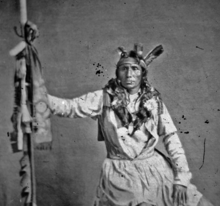 Chief Little Crow – Taoyateduta
Chief Little Crow – Taoyateduta
A portrait: made in Washington, D.C. (1858)
This is some of what happened…
These are the main actions of the six week war.
There were numerous other confrontations between
settlers, the military and the Dakota.
Wk. 31, 08/04/1862 – Just under the wire!
Wk, 33, 08/15/1862 – Refused food and supplies
Wk, 33, 08/16/1862 – Treaty Payments at St. Paul…
Wk, 33, 08/17/1862 – Dakota Hunting Party – It begins!
Wk, 33, 08/18/1862 – Andrew J. Myrick
Wk, 33, 08/18/1862 – shotgun in a blanket
Wk, 33, 08/18/1862 – Battle of Redwood Ferry
Wk, 33, 08/18/1862 – 1st attack on New Ulm, MN
Wk.34, 08/20/1862 – Lake Shetek Massacre, aka: Slaughter Slough
Wk.34, 08/20/1862 – Attack on Fort Ridgley
Wk.34, 08/20/1862 – West Lake Settlement Massacre
Wk.34, 08/22/1862 – Second attack on Fort Ridgley
Wk.34, 08/23/1862 – 2nd. attack on New Ulm, MN
Wk. 35, 08/31/1862 – Battle of Birch Coulee
Wk. 35, 09/02/1862 – Battle of Birch Coulee
Wk. 36, 09/03/1862 – Routed!
Wk. 36, 09/03/1862 – Minnesota’s volunteer militia
References – Dictionary – United States Volunteers
Wk. 36, 09/06/1862 – Military Department of the Northwest.
Wk. 38, 09/23/1862 – Battle of Wood Lake
Photo Gallery Index – Indian Photos – “People escaping from the Indian massacre of 1862…
Wk. 07, 02/19/1891 – Henry Hastings Sibley
Quotes Index – Commentators Quotes & Indian Quotes
By the end of the war, 358 settlers had been killed, 77 soldiers and 29 volunteer militia.
Total Dakota casualties are unknown.
Prisoners at Camp Release
The surrendered Dakota warriors and their families were held captive while the trials took place. They were not tried in a state or federal criminal court, but before a military commission composed completely of Minnesota settlers. Between September 28 and November 5, 1862, the commission, created by Sibley, conducted 392 trials for murder, participation in murder, participation in combat, and rape. It was a kangaroo court with no lawyers for the defendants. Some of the “trials” lasted only a few minutes. By November 5, the commission had sentenced 307 men to death and given 16, prison terms. Sibley approved all death sentences except for one and passed the results on to General John Pope; by November 7, they had cut the total number of death sentences to 303. On December 6, 1862, President Abraham Lincoln approved only 39 of the 303 death sentences after having two advisors review them. A few weeks prior to the executions, the convicted men were transported to Mankato, MN
Thirty-eight men were hanged at Mankato , MN (12/26/1862). Including at least one whose sentence had been commuted by President Lincoln. The largest mass hanging in U.S. History was completed. There were numerous wars between Americans/the United States and the Indian nations, but criminal sanctions to punish those defeated in war were only applied here. It did not occur anywhere else in the Old West.
Various estimates determined that there were perhaps 7,000 Mdewakanton, of these, not much more than a 1,000 were thought to have precipitated the war or participated in it. Maybe 300 Sissetons and Wahpetons may been involved in the fighting. A small fraction of the 4,000 who lived around the Upper Sioux Agency All of this, in defiance of tribal elders, who had opposed participation in what they warned would be a suicidal offensive. The entire Dakota Tribe suffered the consequences. {001}
see:
Wk. 52, 12/26/1862 – Mankato Hanging
Photo Gallery Index – Hangings and Shootings (Caution! – Mankato Hanging
Dakota Internment/Concentration Camp
Fort Snelling, MN (c.1863)
Lieutenant Colonel William R. Marshall commanding the Eighth and Fifth Minnesota Infantry, had 300 troops to execute the forced removal of the Dakota non-combatants (starting 11/07/1862) to Fort Snelling. MN,* from the Minnesota River Valley. The majority were women, children, and the elderly. They arrived at Fort Snelling and were encamped on a bluff above the Minnesota River about a mile west of the fort. (11/13/1862). They were soon moved to a location, on the river at the foot of the bluff, directly below the fort. December saw a 12 foot stockade erected around the two or three acres allotted to the 1,658 Indians the military claimed to have in the camp. This was for the “protection” of the residents from the settlers, and the soldiers, after one of the native women was assaulted. (Previously, there had been some reports of attacks on tribal settlements by angry whites.) A hospital and a mission station were located in a warehouse just outside of the stockade. The Sixth, Seventh, and Tenth Minnesota Volunteer Infantry Regiments enforced residence in the stockade and controlled access in or out.
The prisoners were coerced and manipulated to relinquish their own culture and religion. Due to the harsh conditions, disease and an outbreak of measles, an estimated 130 to 300 (12 to 15%) Indians died over the winter (1862–63).
see:
* The Originals Index – Western Forts and Trading Posts – Military Forts – Fort Snelling, MN
References – Dictionary – United States Volunteers
![]()
Post War Issues
Rape and abuse of captives by the Dakota: There had been at least one widely reported of rape on the first evening of the conflict. 40 women between the ages of twelve and forty were in the group of white captives taken during the war. Among the varied motives for young Dakota warriors to participate in the conflict: revenge, plunder, and perhaps to gain honors in warfare, was the opportunity to acquire a wife. Historian Gary Clayton Anderson states that nearly all of the young girls taken captive and most of the middle-aged women were forced into relationships which Dakota men perceived as “marriage.”
There were also, three well documented cases of female captives who were “adopted” and protected by Dakota families from potential aggressors.
Rape and abuse by the whites after the war: Indian women lacked protection after so many Dakota men were incarcerated. They faced years of abuse and rape by white men It was part of the intense pressure to drive all Indians from the state. Treaties with the Dakota were nullified and Sibley prosecuted an undeclared continuation of the war to rid the state all Indians. Captured Indians were soon sent to reservations in the Dakotas and Nebraska.
The state offered a reward for the scalp of any Dakota man killed in Minnesota.
see:
Wk, 27, 07/03/1863 – Chief Little Crow killed
Intent on pursuing the war against the Dakota people, from the spring of 1863 until the late summer of 1864, the US Army launched the Punitive Expeditions into Dakota Territory, using Fort Snelling as a base of operations. Dakota, captured or surrendered, were held at the Fort Snelling internment camp until they could be removed from the state. Laws were passed by Congress to exile all Indians from the state.*
see:
* Wk. 07, 02/16/1863 – Congress takes everything back
* Wk. 09, 03/03/1863 – cast them all out!
Timelines – Timelines M-Z – Time to Ponder – First Article – Discovery Doctrine
Wk.45, 11/11/1865 – A Final Act
The Dakota people survived the extermination policies following the war.
Although some were able to stay in their homelands of the Mni Sota region,
most were forced out of the state.
All of these issue resonate with the Tribe yet today!
for further references similar to the Dakota War of 1862 on Old West Daily Reader…
see:
Wk. 48 11/12/1868 – The Washita Massacre – Custer attacks a peaceful winter camp.
Wk. 40, 10/03/1873 – The Modoc War – Hangings, and a cost assessment.
Wk. 32, 08/09/1877 – Battle of Big Hole – Fleeing Nez Perce attacked.
Wk.52, 12/29/1890 – The Wounded Knee Massacre
Timelines Master Index – Timelines A-L – Indian Wars Timeline
The Originals Index – Battlefields and Massacres – Massacres of Indians
The Originals Index – Native American Tribes – Plains Indians – The Sioux Nation
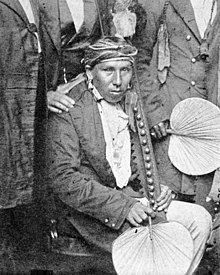
Sub-Chief Blue Earth Mankato
killed by a cannon ball
at the Battle of Wood Lake
Photo: U.S. PD pre-1862

End – Dakota War (1862)
Return to Native American Tribes.
{001} C 02/24; E 02/24; F 02/23; P 03/23
